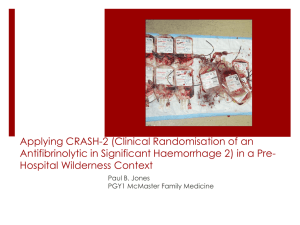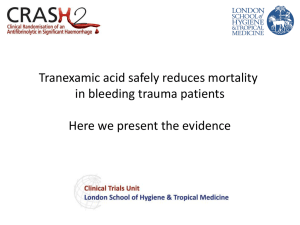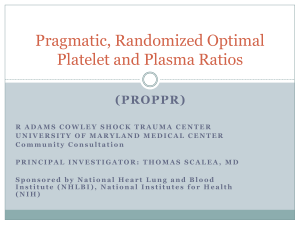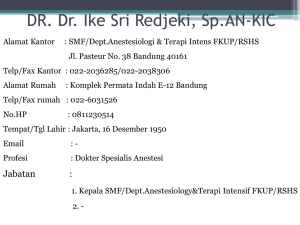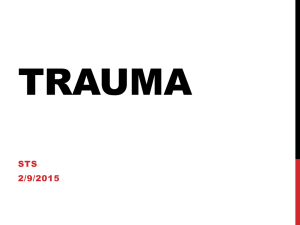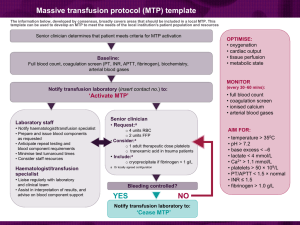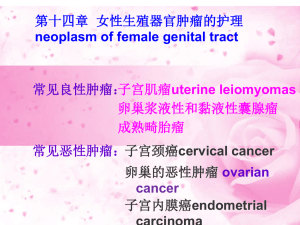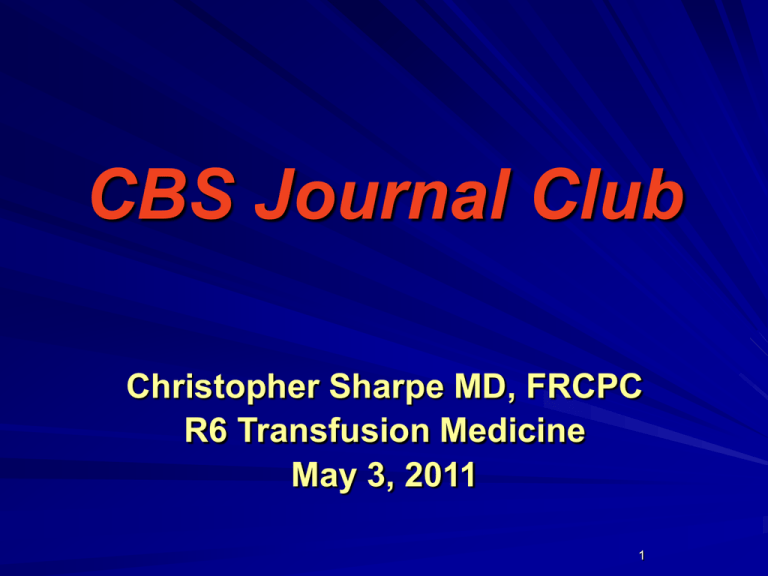
CBS Journal Club
Christopher Sharpe MD, FRCPC
R6 Transfusion Medicine
May 3, 2011
1
Objectives
• to discuss the role of tranexamic acid in
coagulation/fibrinolysis
• to discuss the role of tranexamic acid in
the prevention of bleeding during surgery
and other clinical settings
• to discuss the role of tranexamic acid in
the treatment of bleeding trauma patients
2
Focus of Journal Club
“Effects of tranexamic acid on death,
vascular occlusive events, and blood
transfusion in trauma patients with
significant hemorrhage (CRASH-2):
a randomised, placebo-controlled trial ”
CRASH-2 trial collaborators
Lancet 2010; 376:23-32
CRASH-2 (Clinical Randomisation of an Antifibrinolytic
in Significant Hemorrhage 2)
Introduction
• trauma is a significant cause of mortality,
especially in the developing world
• 33% of trauma deaths in-hospital are
attributed to bleeding
• the hemostatic responses to trauma and
major surgery are similar (fibrinolysis and
hyper-fibrinolysis are stimulated)
4
Introduction
• tranexamic acid: a synthetic derivative of
lysine
• lysine binding sites on plasminogen are
required for the binding of plasminogen
and tPA to fibrin
• tranexamic acid competitively inhibits
these interactions and inhibits fibrinolysis
5
The Fibrinolytic System
• Initiation Phase
- release of tPA from endothelial cells initiates limited
conversion of plasminogen (Plg) to plasmin (Plm)
- binding of tPA and plasminogen to C-terminal lysine
(Lys) residues of partially-degraded fibrin increases the
rate of plasmin formation
tPA
Plg
Plm
tPA
Lys
Lys
6
The Fibrinolytic System
• Propagation Phase
- continuous cleavage of fibrin by plasmin generates new
C-terminal lysine (Lys) residues which act as additional
templates to bind tPA and plasminogen.
Plasmin generation is accelerated
Lys
Plm
Lys
Lys
Lys
Lys
Lys
Lys
7
Introduction
• Antifibrinolytic drugs used in cardiac
surgery can reduce:
- blood loss
- the need for transfusion
- the need for re-operation due to
continued or recurrent bleeding
8
Introduction
• Antifibrinolytic drugs:
- tranexamic acid (lysine analogue)
- epsilon-aminocaproic acid
(EACA; lysine analogue)
- aprotinin (withdrawn in May 2008 due to
concerns of increased risk of death and
cardiovascular complications)
9
Introduction
• tranexamic acid, through its antifibrinolytic
properties, can be used to reduce bleeding in
certain clinical settings:
- menorrhagia
- dental surgery
- elective surgery (knee/hip arthroplasty, spinal
surgery, pediatric craniosynostosis
reconstruction surgery)
• no apparent increase in the risk of postoperative
complications (ie. vaso-occlusive episodes) with
the use of tranexamic acid has been observed
10
Anti-fibrinolytic use for minimizing
perioperative allogeneic blood transfusion
Henry DA, Carless PA, Moxey AJ, et al.
Cochrane Database Syst Rev 2011 Mar 16; 3
• PURPOSE: to assess the comparative effects of the
anti-fibrinolytic drugs aprotinin, tranexamic acid and
epsilon aminocaproic acid (EACA) on:
- blood loss during surgery
- need for red blood cell transfusion
- adverse events (vascular occlusion, renal dysfunction,
death)
• SELECTION CRITERIA:
- randomized controlled trials (RCTs) in adults
undergoing non-urgent surgery which compared
anti-fibrinolytic drugs with placebo (or no treatment), or
with each other
11
Anti-fibrinolytic use for minimizing
perioperative allogeneic blood transfusion
Henry DA, Carless PA, Moxey AJ, et al.
Cochrane Database Syst Rev 2011 Mar 16; 3
• RESULTS: 252 RCTs involving ~25000 patients
• relative risk (RR) for RBC transfusion with tranexamic
acid was 0.61 (95% CI 0.53 to 0.70)
• tranexamic acid did not reduce the need for re-operation
due to bleeding (RR 0.80, 95% CI 0.55 to 1.17)
• compared with no treatment, tranexamic acid did not
increase the risk of myocardial infarction, stroke, renal
dysfunction or overall mortality (based on limited data)
12
Anti-fibrinolytic use for minimizing
perioperative allogeneic blood transfusion
Henry DA, Carless PA, Moxey AJ, et al.
Cochrane Database Syst Rev 2011 Mar 16; 3
• CONCLUSIONS:
- lysine analogues (tranexamic acid) are effective
in reducing blood loss and the receipt of
allogeneic red cell transfusion during and after
surgery
- lysine analogues (tranexamic acid) appear to be
free of serious adverse effects
13
The WOMAN Trial (World Maternal Antifibrinolytic Trial):
tranexamic acid for the treatment of postpartum
haemorrhage: an international randomised, double
blind placebo controlled trial
Shakur H, Elbourne D, Gulmezoglu M, et al. Trials 2010; 11:40
• obstetrical hemorrhage is the leading cause of
maternal mortality (most occurs in the
postpartum period)
• PURPOSE:
- to determine the effect of early administration of
tranexamic acid in women with clinically diagnosed
postpartum haemorrhage on mortality, hysterectomy
and other morbidities (surgical interventions, blood
transfusion, risk of non-fatal vascular events)
14
The WOMAN Trial (World Maternal Antifibrinolytic Trial):
tranexamic acid for the treatment of postpartum
haemorrhage: an international randomised, double
blind placebo controlled trial
Shakur H, Elbourne D, Gulmezoglu M, et al. Trials 2010; 11:40
• METHOD:
- a randomized, double blind, placebo controlled trial
is ongoing in 15000 women with a clinical diagnosis
of postpartum hemorrhage following vaginal delivery
or c-section
- eligibility criterion: clinician's uncertainty whether or
not to use an antifibrinolytic agent in the setting of
postpartum hemorrhage
- patients will be randomization to tranexamic acid
(1 g IV) or placebo (NaCl 0.9%)
15
The WOMAN Trial (World Maternal Antifibrinolytic
Trial): tranexamic acid for the treatment of postpartum
haemorrhage: an international randomised, double
blind placebo controlled trial
Shakur H, Elbourne D, Gulmezoglu M, et al. Trials 2010; 11:40
• ANALYSES:
intention to treat
• PRIMARY ENDPOINT:
mortality or hysterectomy
16
Introduction
• Question yet to be answered:
- does tranexamic acid reduce mortality
and bleeding in trauma patients who are
bleeding?
17
Focus of Journal Club
“Effects of tranexamic acid on death,
vascular occlusive events, and blood
transfusion in trauma patients with
significant hemorrhage (CRASH-2):
a randomised, placebo-controlled trial ”
CRASH-2 trial collaborators
Lancet 2010; 376:23-32
CRASH-2 (Clinical Randomisation of an Antifibrinolytic
in Significant Hemorrhage 2)
CRASH-2
• placebo-controlled trial to assess the
effects of the early administration of a short
course of tranexamic acid in trauma
patients with, or at risk of, significant
hemorrhage on:
- death
- vascular occlusive events
- the receipt of blood transfusion
19
CRASH-2: Methods
• 274 hospitals in 40 countries involved in trial
• Eligibility criteria:
- adult trauma patients with significant
hemorrhage (SBP < 90 mmHg or HR > 110 BPM,
or both) within 8 hours of injury
- adult trauma patients who were considered to
be at risk of significant hemorrhage within 8
hours of injury
20
CRASH-2: Methods
• patient entry into study was “governed by the uncertainty
principle”
• if a clear indication for tranexamic acid was felt to be
present by the responsible doctor, trauma patients were
not randomized into the study
• if a clear contraindication to tranexamic acid treatment
was felt to be present by the responsible doctor, trauma
patients were not randomized into the study
• patients were eligible for randomization when the
responsible doctor was “substantially uncertain” as to
whether or not to treat a patient with tranexamic acid
21
CRASH-2: Methods
• informed consent was obtained from
trauma patients if possible (or a relative or
representative if this was not possible)
• consent was deferred or waived if above
option not available (and obtained later if
possible)
22
CRASH-2: Methods
• randomization was balanced by centre, with an
allocation sequence based on a block size of eight,
generated with a computer random number
generator
• the telephone randomization service used a
minimization algorithm balancing for:
- sex
- time since injury
- systolic blood pressure
- central capillary refill time
- type of injury
(blunt or penetrating)
- age
- Glasgow Coma Score
- country of origin
- respiratory rate
23
CRASH-2: Methods
• Randomization options:
- telephone randomization using the University of
Oxford Clinical Trial Service Unit (CTSU)
- local treatment pack system (the pack number
was sent to the international trial coordinating
centre in London, UK)
24
CRASH-2: Methods
• once the treatment pack number was recorded,
the patient was included in the trial whether or
not the treatment pack was opened or the
allocated treatment started (intention to treat
analysis)
25
CRASH-2: Methods
• Random assignment to receive either:
- a loading dose of 1 g of tranexamic acid IV over 10
min followed by 1 g IV over 8 hours
OR
- matched placebo (0.9% saline IV)
• each treatment pack was numbered and contained
four IV doses of either tranexamic acid 500 mg or IV
placebo (0.9% saline)
• tranexamic acid and placebo were indistinguishable
(IV amps)
26
CRASH-2: Methods
• study participants, site investigators, and trial
coordinating centre staff were masked to
treatment allocation
• emergency unblinding was available by calling
the University of Oxford Clinical Trial Service Unit
(CTSU)
27
CRASH-2: Methods
• Primary outcome: death in hospital within
4 weeks of injury
• Cause of death categories:
- bleeding
- vascular occlusion (stroke, myocardial infarction,
pulmonary embolism)
- multiorgan failure
- head injury
- other
28
CRASH-2: Methods
• Treatment effects on the primary outcome were
subdivided by four baseline characteristics:
1) estimated time since injury (<1h, 1-3h, 3-8h)
2) systolic blood pressure (≤75, 76-89, ≥90mmHg)
3) Glasgow Coma Scale (severe 3-8, moderate 9-12,
mild 13-15)
4) type of injury (penetrating or blunt)
29
CRASH-2: Methods
• Secondary Outcomes:
- vascular occlusive events
(myocardial infarction, stroke, pulmonary embolism,
deep vein thrombosis)
- surgical intervention
(neuro/thoracic/abdominal/pelvic surgery)
- receipt of blood transfusion
- number of units of blood products transfused
30
CRASH-2: Methods
• Other data collected:
- level of dependency post-traumatic injury
was measured using the 5-point Modified
Oxford Handicap Scale at hospital
discharge or on day 28 if still in hospital
31
CRASH-2: Methods
• Categories of Oxford Handicap Scale:
- dead
- fully dependent requiring attention day and
night
- dependent but not requiring constant attention
- independent (some restriction in lifestyle)
- minor symptoms
- no symptoms
32
CRASH-2: Methods
• Other data collected:
- use of recombinant factor VIIa
- gastrointestinal bleeding complications
- adverse events that were “serious, unexpected,
and suspected to be related to the study treatment”
• outcomes were recorded if they occurred while the
patient was still in hospital (up to 28 days after initial
randomization)
• trial coordinating centre in London had central
database
33
CRASH-2: Statistics
• a trial of 20000 patients was planned in order
to achieve a 95% chance of a two-sided
p-value of < 0.05 (and a 2% survival
difference)
• all analyses were on intention to treat basis
• for primary outcome analyses, relative risks
were calculated with 99% CIs with two-sided
p-values
34
CRASH-2: Statistics
• heterogeneity in treatment effects across
subgroups was assessed with chi-square
(Χ2) tests
• missing data was not imputed into the
database
35
Figure 1: Trial Profile
36
Table 1: Baseline Data of
Participants
37
Table 1: Baseline Data of
Participants
38
Figure 2: Mortality by Days
from Randomization
39
Table 2: Death by Cause
40
Table 3: Vascular Occlusive Events, need for
transfusion and surgery, and level of
dependency
41
Figure 3: All-cause mortality
by subgroup
•
GCS (Glasgow Coma Scale) *95% CI
42
CRASH-2: Results
No emergency unblinding was required during
the study
No adverse events were recorded that were
“serious, unexpected, or suspected to be
related to the study treatment “
4
33
CRASH-2: Discussion
• trial inclusion criteria were clinically-based (not
based on laboratory tests)
- overt bleeding may be easily identified but
judging patients at risk for bleeding in the setting
of trauma is difficult
- it is possible that some of the patients
randomized may not have been bleeding at the
time of randomization (reduced power of trial)
• vascular occlusive events were recorded in the
study only when there was clear clinical evidence
- under-reporting of events may have occurred
4
33
CRASH-2: Discussion
• the mechanism of action of tranexamic acid in
reducing all-cause mortality in the setting of
traumatic bleeding is not fully clear from the trial
design
- ? prevention of hyperfibrinolyis vs. other mechanism ?
• fibrinolytic activity was not measured in this trial
(ie. D-dimer, FDPs, plasmin-α2 antiplasmin
complex, plasmin-α2 macroglobulin complex,
Bβ 1-42 fragment, Bβ 14-42 fragment, euglobulin
clot lysis time)
• further study is needed to define the mechanism
of action of tranexamic acid in this setting
4
33
CRASH-2: Discussion
• What is the optimal time to give tranexamic acid
to a bleeding trauma patient post-injury?
- most deaths due to trauma are from bleeding
that occurs within the first few hours after injury
- giving tranexamic acid when bleeding is most
likely (ie. early on) and avoiding it when vascular
occlusive event risk is highest (ie. later on) is
likely appropriate and appears safe since there
was no increase in the risk of fatal or non-fatal
vascular occlusive events when tranexamic acid
was given within eight hours of injury
4
33
CRASH-2: Discussion
• What is the optimal dose of tranexamic acid to prevent
bleeding?
- results from studies in surgical patients showed no
significant difference between high and low doses on
blood loss and blood transfusion
- low dose 2.5 mg/kg loading dose with 0.25 mg/kg/h
over 1-12 hours
- high dose 100 mg/kg loading dose with 4 mg/kg/h over
1-12 hours
Tranexamic acid dose used in this trial (for a 70 kg
patient): ~15 mg/kg loading dose with 1.8 mg/kg/h over
4
33
1-12 hours
CRASH-2: Discussion
• What is the optimal dose of tranexamic acid to
prevent bleeding?
- the fixed dose that was given in the trial was chosen
because it was within the range shown to inhibit
fibrinolysis without producing adverse effects
- giving a fixed dose is reasonable in the setting of
traumatic bleeding (obtaining the weight of a patient
is difficult)
- would higher tranexamic acid doses be of benefit?
4
33
CRASH-2: Discussion
• Is the use of tranexamic acid warranted in other
bleeding settings?
- traumatic brain injury with intracranial
hemorrhage (studies are lacking)
- post-partum hemorrhage
(WOMAN Trial ongoing)
4
33
Critical Appraisal
• Are the results valid?
• YES
- large numbers of patients were enrolled in the study
- baseline characteristics of the patients were
matched at the start of the trial
- the assignment of patients to treatment was
randomized which ensured that patients, clinicians,
and study personnel who treated bleeding trauma
patients were blinded as to the presence or absence
of the intervention
4
33
Critical Appraisal
• Are the results valid?
• YES
- groups were treated equally with the exception of the
study intervention
- all of the study subjects were accounted for by the end of
the trial (and most were followed up)
4
33
Critical Appraisal
• Are the results valid?
- the decrease in all-cause mortality with tranexamic acid
was statistically significant (14.5% in tranexamic acid
group vs. 16.0% in placebo group; RR 0.91, 95% CI 0.850.97; p=0.0035 )
- results are clinically relevant and widely generalizable
- “uncertainty principle” which guided patient entry into the
study is subjective (no explanation was provided as to
what constitutes a clear indication for, or against, the use
of tranexamic acid in the setting of traumatic)
4
33
Critical Appraisal
• Are the results valid?
- the
use of intention to treat was
appropriate in this trial since most of the
patients randomized to receive treatment
actually received what was intended
4
33
Critical Appraisal
• What are the results?
- tranexamic acid showed a reduction in allcause mortality compared to placebo (14.5% vs.
16.0%; RR 0.91, 95% CI 0.85-0.97; p=0.0035)
- tranexamic acid showed a reduction in the risk
of death due to bleeding compared to placebo
(4.9% vs. 5.7%; RR 0.85, 95% CI 0.76-0.96;
p=0.0077)
4
33
Critical Appraisal
• How can I apply the results to patient care?
- encourage the use of tranexamic acid early on
in the setting of trauma patients who are
bleeding (or who may bleed) in order to reduce
all-cause mortality and the risk of death due to
bleeding (data shows that a substantial number
of trauma patients die early after injury, and
many die from bleeding)
- monitor adverse events (such as vascular
occlusion) when tranexamic acid is used in the
setting of traumatic bleeding
55
Critical Appraisal
• How can I apply the results to patient
care?
- the results can (and likely should) be applied to
bleeding trauma patients worldwide since the
trial involved patients from 40 countries
- clinical inclusion criteria for tranexamic acid use
in the setting of bleeding trauma patients are
available and feasible worldwide
56
Critical Appraisal
• How can I apply the results to patient
care?
- the benefits of treatment with tranexamic acid in
the setting of traumatic bleeding are worth the
cost
- cost of 2 g IV of tranexamic acid:
$54 in Canada
- tranexamic acid is relatively simple to administer
57
Critical Appraisal
• How can I apply the results to patient
care?
- the harms associated with tranexamic acid use
in bleeding trauma patients appear to be
acceptable: the vaso-occlusive event rate is not
increased
58
Questions or
comments?
16

